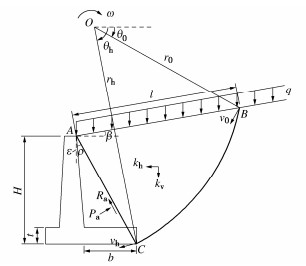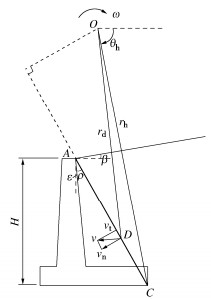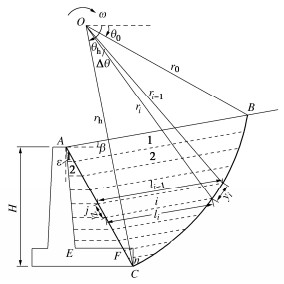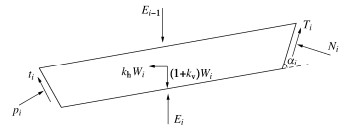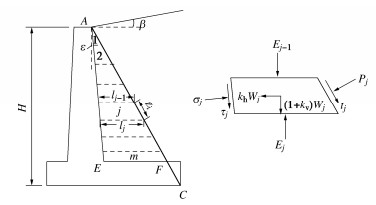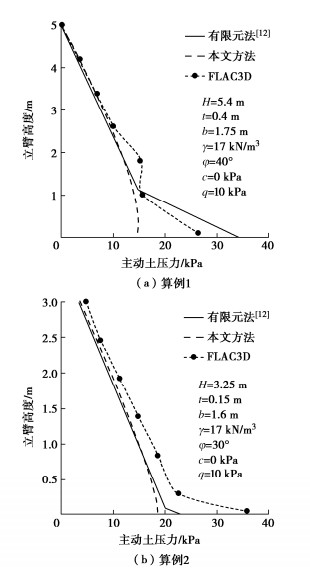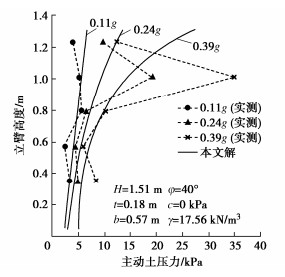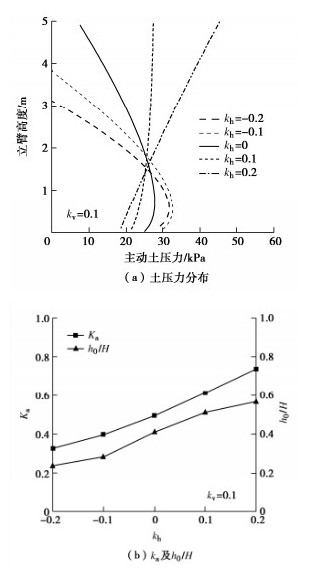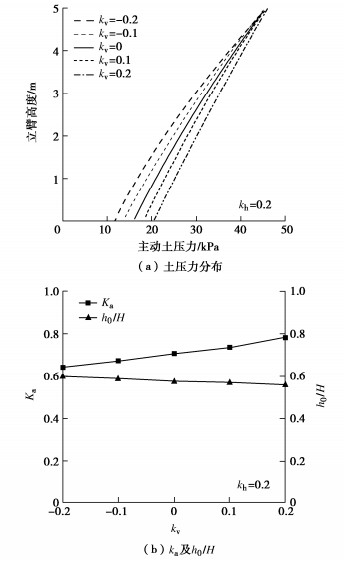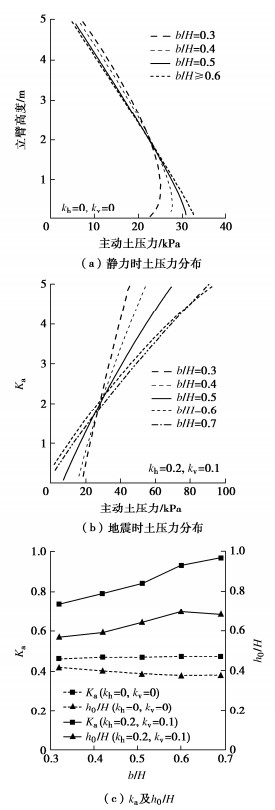Method for calculating seismic active earth pressures on cantilever retaining walls
-
摘要: 为确定悬臂式挡土墙立臂的地震主动土压力,针对墙后填土的5种可能失稳破坏模式,基于对数螺旋式滑裂面形态,采用极限分析上限定理与拟静力法推导了作用于假想坦墙背上的地震土压力合力;在此基础上,对坦墙背后滑楔体、立臂与坦墙背之间的土体分别采用斜条分与水平条分法,并通过土压力合力的上限解对坦墙背上的土压应力进行修正,进而求得立臂上的土压力分布。实例分析表明,立臂静土压力沿深度分布呈顶点位于下部的抛物线模式;地震土压力分布一般呈非线性递减模式,计算值与试验值有良好的一致性;两种工况下合力作用点分别位于立臂下半段与上半段。参数分析显示,水平地震影响系数、踵板宽度和立臂倾角的增加均使立臂中上部地震主动土压力显著增大;地震条件下增长踵板宽度会导致立臂受力增加。在强震条件下,本法得到的立臂土压力比铁路规范法的结果高出约9%~14%,立臂底端弯矩更显著高于规范法结果,规范法进行强震条件下悬臂墙的抗震设计可能偏于不安全。Abstract: In order to determine the seismic active earth pressures on the stem of a cantilever wall, the resultant of the earth pressures on the assumed plane wall back is firstly derived using the upper-bound limit analysis and the pseudo-static method for five types of potential failure modes based on the log-spiral slip surface. The oblique and horizontal slice methods are secondly adopted respectively for the slide wedge mass and the local soils between the stem and the plane wall back to determine the earth pressure distribution on the stem, in which the earth pressure on the plane wall back are calibrated by the upper bound solution for the resultant of earth pressures. Some examples show that the proposed distribution of the earth pressures on the stem with depth takes on a parabolic profile with the peak point on the lower segment of the stem under the static condition, whereas it presents a nonlinear decreasing mode fairly identical with the test results under the seismic condition. The application point of the resultant is located on the lower and upper segments of the stem under the static and seismic conditions, respectively. The parameter study shows that the increase of horizontal seismic coefficient, heel plate width and stem back inclination induces a significant increase of the seismic active earth pressures on the middle and upper segments of the stem. Under the seismic condition, broadening the width of heel plate can cause the increase of the stresses on the stem. In particular, the proposed earth pressures on the stem are 9%~14% higher than those by China's code for design of retaining structures of railway earth works under strong earthquakes, and the proposed bending moments at the stem bottom are noticeably greater than those by the above code, which naturally means the Norm is not safely suitable for the aseismic design under strong earthquakes.
-
0. 引言
高速铁路以其速度快、运输能力大、舒适方便等优点成为我国大力发展的交通基础设施。随着高铁网络迅速扩张以及运营速度的不断提高,列车运行引起的沿线地面环境振动问题也逐渐成为人们关注的焦点[1-2]。近年来,许多学者针对轨道交通地面环境振动开展了大量的理论、数值和现场实测研究[2]。
本文基于巴黎—布鲁塞尔高铁某路堑段地面环境振动现场实测,分析路堑段地面振动特性和传播衰减规律。在此基础上,推导并建立高铁荷载下路堑段2.5维有限元动力计算模型,对比分析路堑深度和路堑边坡坡度对地面环境振动特性的影响。
1. 高铁路堑段地面振动实测
1.1 测试概况
路堑测试段取自巴黎—布鲁塞尔高速铁路[3-4],位于比利时Braffe小镇西北侧,如图 1。线路为有砟轨道,采用UIC 60型钢轨和预应力轨枕,道床由0.3 m厚道砟层和0.2 m厚底砟层组成。测试采用SM-6型振动检波仪,灵敏度28.8 V/m/s,采样频率1000.0 Hz(图 2)。
如图 3所示,在路堑测试段距轨道9.0~35.0 m范围内依次布置8个测点,监测并记录高速列车通过路堑测试段时引起的地面环境振动。测试段路堑深度为7.2 m,路堑边坡坡度为25.0°。路堑测试段的地基土层分布与物理力学参数如表 1所示。
表 1 路堑测试段土层参数Table 1. Mechanics parameters for cutting土层 厚度/m 弹性模量E/MPa 泊松比μ 阻尼比ξ 密度ρ/(kg·m-3) 剪切波速VS/(m·s-1) 道砟层 0.30 150.00 0.30 0.030 1700.0 184.21 底砟层 0.20 250.00 0.30 0.030 1900.0 224.96 ①1粉土 1.35 108.95 0.33 0.077 1600.0 160.00 ①2粉土 1.35 124.45 0.33 0.070 1600.0 171.00 ②1砂土 3.10 256.60 0.29 0.031 2000.0 223.00 ②2砂土 3.10 348.82 0.29 0.050 2000.0 260.00 注:表中土层厚度从道床底面算起,道床底面以上7.2 m厚的土层同①1。 列车荷载由TGV高速列车提供,列车由两端各一节动力车厢和中间6节客运车厢组成,其几何尺寸、物理参数分别如图 4和表 2所示。实测时,TGV列车以294.7 km/h的速度通过路堑测试段。
表 2 TGV高速列车参数Table 2. Parameters of TGV high-speed train项目 头(尾)车 中间车 车身质量/kg 55790.00 24000.00 转向架质量/kg 2380.00 3040.00 轮对质量/kg 2048.00 2003.00 一级悬挂刚度/(MN·m-1) 2.45 1.40 一级悬挂阻尼/(kN·s·m-1) 20.00 120.00 二级悬挂刚度/(MN·m-1) 2.45 0.45 二级悬挂阻尼/(kN·s·m-1) 40.00 40.00 1.2 路堑测试段地面振动时频特性
路堑测试段与轨道不同间距处的地面竖向振动加速度时程曲线如图 5所示。由图可知,距轨道较近处,可从时程曲线中清晰地分辨出由列车轮对引起的一系列周期性分布的振动加速度峰值。距路堑段轨道9.0 m处,头(尾)车引起的地面振动幅值略大于中间车,这主要是由于头(尾)车质量大于中间车所致(表 2)。随测点与轨道间距增加,列车运行引起的地面振动幅值逐渐减小,测点与轨道距离≥19.0 m后,列车轮对的周期性激励作用逐渐模糊。此外,距轨道较远处,中间车引起的地面振动幅值略大于头(尾)车,这主要是由中间车相邻转向架轮对引起的振动叠加效应所致。
利用Fourier变换对地面振动时程进行处理,得到竖向振动加速度频谱图(图 6)。从图中可知,近轨道处的地面振动频率成分较为丰富,且以20.0~90.0 Hz频段为主。随测点与轨道距离增加,地面振动的中高频成分迅速衰减,而40.0 Hz以下频段的振动衰减速度较慢,测点与轨道距离≥35.0 m后路堑段地面振动主要集中在20.0~40.0 Hz之间。此外,高铁荷载下路堑段地面振动1阶主频随与轨道距离的增加基本维持在26.8 Hz左右,接近列车以294.7 km/h运行条件下的荷载基频(f1=c/L1=27.3 Hz,图 4,L1=3.0 m)[5]。
1.3 路堑测试段地面振动衰减特性
高铁荷载下路堑测试段地面竖向振动加速度峰值随测点与轨道距离增加的衰减曲线如图 7所示。从图 7分析可知,高铁荷载下路堑段地面环境振动随测点与轨道距离增加的衰减过程大致可分为3个阶段。阶段Ⅰ:距轨道9.0~15.0 m范围内,路堑段地面竖向振动加速度峰值迅速衰减,距轨道15.0 m处的地面振动峰值相较于距轨道9.0 m处减小了50.2%,称为“快速衰减”阶段。阶段Ⅱ:距轨道15.0~27.0 m范围内,路堑段地面竖向振动加速度峰值的衰减速度略小于距轨道15.0 m范围内,称为“较快衰减”阶段。阶段Ⅲ:地面竖向振动加速度峰值的衰减速率随测点与轨道距离增加进一步减缓,称为“缓慢衰减”阶段。此外,从图 7中可以看出,高铁荷载下路堑测试段地面振动峰值在堑顶处(距轨道19.0 m处)有较为明显的振动放大现象,这主要是由于瑞利波在堑顶处发生绕射所致[6]。
2. 2.5维有限元模型的建立与验证
2.5维有限元法通过在列车运行方向上进行波数展开,并对时间t进行Fourier变换,将3维动力问题转换为频域-波数域内的问题进行求解,再对结果进行Fourier逆变换得到时域-空间域内的解答。图 8为本文建立的路堑段2.5维有限元模型,记x方向为列车运行方向,z方向为竖直方向,y方向为水平面内垂直轨道方向,定义对时间t和坐标x的双重Fourier变换如式(1a)所示,对应的逆变换如式(1b)所示。
˜ˉu(ξx,y,z,ω)=+∞∫−∞+∞∫−∞u(x,y,z,t)eiξxxe−iωtdxdt, (1a) u(x,y,z,t)=14π2+∞∫−∞+∞∫−∞˜ˉu(ξx,y,z,ω)e−iξxxeiωtdξxdω, (1b) 式中:上标“-”和“~”分别用于表示频域和波数域内的量;ω为圆频率;ξx为x方向上的波数。
2.1 轨道模型与列车荷载
既有研究表明[7],是否考虑钢轨下各部分耦合对列车荷载下地面振动计算结果的影响较小,故本文假定轨道结构在列车荷载下发生整体变形,并将其简化为铺设在路基上的Euler梁,轨道梁在频域-波数域内的动力方程如下:
(EIξ4x−mω2)˜ˉur=˜ˉfT(ξx,ω)+˜ˉp(ξx,ω), (2) 式中:EI为轨道结构弯曲刚度;ur为振动位移;m为轨道结构的综合质量;˜ˉfT为轨道与路基间的相互作用力;˜ˉp为列车荷载。
采用连续轴重荷载模拟列车荷载[1],其频域-波数域内的表达式为:
˜ˉP(ξx,ω)=N∑n=12πcδ(ξx−ω−ω0c)χn(ξx), (3) 式中:χn(ξx)=pn[e−iξxn−1∑m=0Lm+e−iξx(n−1∑m=0Lm+a)+e−iξx(n−1∑m=0Lm+a+b)+e−iξx(n−1∑m=0Lm+2a+b)];N为列车车厢数量;pn为列车第n节车厢的单个轮对荷载;Lm(m=1, 2, 3, …)为第m节车厢的长度,L0为第1节车厢第1组轮对至坐标原点的距离;a为单个转向架下2个轮对间的距离;b为同一车厢下2个转向架的间距。
2.2 路堑段2.5维有限元模型
Xia等[8]研究指出,轨道交通荷载引起的土体应变量一般为10-5或更小量级,产生的振动波属于弹性波。因此,本文将地基土体视为黏弹性介质,其本构方程如下:
σij=2μdεij+λdδije, (4) 式中:σij为应力张量;εij=(ui,j+uj,i)/2,为应变张量;δij为Dirac函数;e为体应变;i,j代表空间坐标系x,y和z轴;λd和μd为考虑材料阻尼的Lamé常数,由式(5)算得。
λd=λ(1+2βi);μd=μ(1+2βi)。 (5) 式中:λ=Eν/[(1+ν)(1−2ν)];μ=E/2(1+ν);E为弹性模量;ν为泊松比;β为阻尼比;i为虚数单位。
将本构方程代入动力方程σij,j+Fi=ρ¨ui,得到以位移表示的运动方程:
μdui,jj+(λd+μd)uj,ji=ρ¨ui, (6) 式中,ρ为密度,上标“··”表示对时间的2阶导数。
利用式(1a)对上式进行双重Fourier变换,结合应力边界条件˜σijnj−˜fi=0,基于Galerkin法,并采用8节点等参单元进行离散,整理得到频域-波数域内的有限元控制方程,其矩阵形式如下:
(˜ˉK−ω2M)˜ˉU=˜ˉF, (7) 式中:˜ˉK为刚度矩阵;M为质量矩阵;˜ˉU为位移列阵;˜ˉF为等效节点力列阵。
为消除模型截断边界处的反射波对计算结果造成影响,基于笔者先前的研究[1],采用无限元边界作为模型的边界条件。此外,高速铁路地面环境振动特性研究中通常仅考虑单次列车荷载作用,不同于列车循环荷载,单次列车荷载引起的土体固结沉降可忽略不计[1]。因此,本文所建立路堑段2.5维有限元模型中各部分之间采用共节点的方式链接。
2.3 数值方法验证
为验证本文2.5维有限元方法的正确性,基于前文TGV列车(表 2、图 4)和路堑测试段参数(图 3、表 1),建立高铁荷载下路堑段2.5维有限元模型。考虑车速294.7 km/h,路堑段地面竖向振动加速度峰值随测点与轨道距离衰减的实测与计算结果如图 9所示。由图可知,本文建立的2.5维有限元模型能较好地反映出高铁荷载下地面振动随测点与轨道距离的衰减趋势,与实测值相比,计算误差不超过13%,满足精度要求,验证了模型的正确性和可靠性。
3. 路堑参数对地面振动的影响
考虑单线轨道,建立如图 8所示的路堑段2.5维有限元模型,模型宽100.0 m、深35.0 m,路堑底面宽度为8.6 m。选取CRTS II型板式无砟轨道[5],并模拟为铺设在路基上的Euler梁。地基土体的弹性模量E、泊松比ν、阻尼比ξ、密度ρ和瑞利波速vR分别为64.0 MPa,0.38,0.05,1850.0 kg/m3,382.68 km/h。综合考虑计算效率与精度,选取6节编组的CRH380 AL型动车组作为列车荷载[5],分析路堑设计参数对地面环境振动特性的影响。
3.1 路堑深度的影响
考虑车速为380.0 km/h,路堑边坡坡度为1.00∶1.25,不同路堑深度条件下(2.0,4.0,6.0,8.0 m)地面竖向振动加速度峰值随测点与轨道中心距离的变化曲线如图 10所示,并增设0.0 m的无路堑工况进行对比分析。由图 10可知,不同路堑深度条件下的地面振动均小于无路堑工况(0.0 m)。既有研究指出近轨道处的地面振动衰减由几何阻尼主导[9],路堑的存在增加了近轨道处的几何阻尼,从而减小了高铁运行引起的地面振动加速度峰值,且减振效果随路堑深度增加逐渐增强。当路堑深度≥6.0 m时,继续增加路堑深度将难以进一步有效减小地面环境振动。此外,由于堑顶处的瑞利波绕射[6],不同路堑深度条件下(2.0,4.0,6.0,8.0 m)其堑顶处附近(分别距轨道中心6.8,9.3,11.8,14.3 m)均可观察到地面振动的局部放大现象。
3.2 路堑边坡坡度的影响
我国高速铁路路堑边坡的设计坡度通常介于1.00∶1.75~1.00∶0.75之间[10]。考虑路堑深度为6.0 m,图 11为车速380.0 km/h时不同路堑边坡坡度条件下(1.00∶1.75~1.00∶0.75)地面竖向振动加速度峰值随测点与轨道中心距离的衰减曲线。由图 11(a)可知,当路堑边坡坡度在1.00∶1.25~1.00∶0.75(38.7°~53.1°)范围内时,地面环境振动随路堑边坡坡度的增大而减小。这主要与瑞利波在堑顶处的绕射程度有关,既有研究指出[6],当路堑边坡坡度在40.0°~60.0°范围内时,堑顶处瑞利波的绕射随坡度增大而减小,从而降低了高铁运行引起的路堑段地面振动。此外,随着路堑边坡坡度的进一步减小(图 11(b)),坡度变化对地面振动加速度峰值的影响较小。因此,实际工程中在保证路堑边坡安全稳定的前提下,较陡的路堑边坡更有利于减小高铁荷载下路堑段的地面环境振动。
4. 结论
(1)列车轴重对路堑段近轨道处的地面振动幅值有重要影响,随测点与轨道距离的增加,地面振动幅值逐渐衰减,中间车相邻转向架轮对引起的叠加效应对地面振动幅值的影响逐渐增强。
(2)路堑段地面振动随测点与轨道距离的衰减过程大致可分为3个阶段,且堑顶处有较明显的振动局部放大现象。中高频成分振动的衰减速率明显大于其他频段,且振动1阶主频由列车荷载的基频(f1=c/L1)主导。
(3)高铁荷载下地面振动随路堑深度增加而减小。当路堑深度超过某一限值(本文为6.0 m)时,继续增加路堑深度难以进一步有效降低地面环境振动。
(4)路堑段地面振动随路堑边坡坡度的增大而减小。在保证路堑边坡稳定性的前提下,较陡的路堑边坡更有利于减小高铁运行引起的地面环境振动。
-
图 2 模式Ⅰ相应的旋转破坏机构
Figure 2. Rotational failure mechanism of Mode Ⅰ in Fig. 1
-
[1] 铁路路基支挡结构设计规范: TB 10025—2019[S]. 北京: 中国铁道出版社, 2019. Code for Design of Retaining Structures of Railway Earthworks: TB 10025—2019[S]. Beijing: China Railway Publishing House, 2019. (in Chinese)
[2] 李海光. 新型支挡结构设计与工程实例[M]. 2版. 北京: 人民交通出版社, 2011. LI Haiguang. Design and Engineering Example of New Retaining Structure[M]. 2nd ed. Beijing: China Communications Press, 2011. (in Chinese)
[3] BARGHOUTHI A F. Active earth pressure on walls with base projection[J]. Journal of Geotechnical Engineering, 1990, 116(10): 1570-1575. doi: 10.1061/(ASCE)0733-9410(1990)116:10(1570)
[4] GRECO V R. Analytical active earth thrust on cantilever walls with short heel[J]. Canadian Geotechnical Journal, 2008, 45(12): 1649-1658. doi: 10.1139/T08-078
[5] GRECO V R. Seismic active thrust on cantilever walls with short heel[J]. Soil Dynamics and Earthquake Engineering, 2009, 29(2): 249-252. doi: 10.1016/j.soildyn.2008.03.003
[6] KARKANAKI A R, GANJIAN N, ASKARI F. Stability analysis and design of cantilever retaining walls with regard to possible failure mechanisms: an upper bound limit analysis approach[J]. Geotechnical and Geological Engineering, 2017, 35(3): 1079-1092. doi: 10.1007/s10706-017-0164-5
[7] ALPER KAMILOĞLU H, SADOĞLU E. Experimental and theoretical investigation of short- and long-heel cases of cantilever retaining walls in active state[J]. International Journal of Geomechanics, 2019, 19(5): 1-17.
[8] CHEN F Q, ZHANG Y B, LIN Y J, et al. Active earth pressure against inverted T-type retaining walls under translation mode[J]. International Journal of Geomechanics, 2021, 21(6): 04021077. doi: 10.1061/(ASCE)GM.1943-5622.0002013
[9] EVANGELISTA A, SCOTTO D S A, SIMONELLI A L. Evaluation of pseudostatic active earth pressure coefficient of cantilever retaining walls[J]. Soil Dynamics and Earthquake Engineering, 2010, 30(11): 1119-1128. doi: 10.1016/j.soildyn.2010.06.018
[10] SCOTTO DI SANTOLO A, EVANGELISTA A. Dynamic active earth pressure on cantilever retaining walls[J]. Computers and Geotechnics, 2011, 38(8): 1041-1051. doi: 10.1016/j.compgeo.2011.07.015
[11] 李志浩, 肖世国. 地震条件下悬臂式挡墙主动土压力的极限分析方法[J]. 中国地质灾害与防治学报, 2020, 31(5): 79-87. https://www.cnki.com.cn/Article/CJFDTOTAL-ZGDH202005012.htm LI Zhihao, XIAO Shiguo. Limit analysis method of active earth pressure on cantilever retaining wall subjected to earthquake[J]. The Chinese Journal of Geological Hazard and Control, 2020, 31(5): 79-87. (in Chinese) https://www.cnki.com.cn/Article/CJFDTOTAL-ZGDH202005012.htm
[12] 戴自航, 林智勇, 郑也平, 等. L型挡土墙主动土压力计算的基底摩擦系数折减有限元法[J]. 岩土工程学报, 2009, 31(4): 508-514. http://manu31.magtech.com.cn/Jwk_ytgcxb/CN/abstract/abstract13209.shtml DAI Zihang, LIN Zhiyong, ZHENG Yeping, et al. Finite element method for computations of active earth pressures acting on L-shaped retaining walls with reduced friction coefficients of base bottoms[J]. Chinese Journal of Geotechnical Engineering, 2009, 31(4): 508-514. (in Chinese) http://manu31.magtech.com.cn/Jwk_ytgcxb/CN/abstract/abstract13209.shtml
[13] CHUGHASHOK K, LABUZJOSEPH F. Numerical simulation of an instrumented cantilever retaining wall[J]. Canadian Geotechnical Journal, 2011, 48(9): 1303-1313. doi: 10.1139/t11-037
[14] 高洪梅, 卜春尧, 王志华, 等. 回填EPS混合土的防滑悬臂式挡墙地震稳定性分析[J]. 岩土工程学报, 2017, 39(12): 2278-2286. http://manu31.magtech.com.cn/Jwk_ytgcxb/CN/abstract/abstract17241.shtml GAO Hongmei, BU Chunyao, WANG Zhihua, et al. Seismic stability of anti-sliding cantilever retaining wall with EPS composite soil[J]. Chinese Journal of Geotechnical Engineering, 2017, 39(12): 2278-2286. (in Chinese) http://manu31.magtech.com.cn/Jwk_ytgcxb/CN/abstract/abstract17241.shtml
[15] JO S B, HA J G, LEE J S, et al. Evaluation of the seismic earth pressure for inverted T-shape stiff retaining wall in cohesionless soils via dynamic centrifuge[J]. Soil Dynamics and Earthquake Engineering, 2017, 92: 345-357. doi: 10.1016/j.soildyn.2016.10.009
[16] 肖世国. 似土质边(滑)坡抗滑桩后滑坡推力分布模式的近似理论解析[J]. 岩土工程学报, 2010, 32(1): 120-123. http://manu31.magtech.com.cn/Jwk_ytgcxb/CN/abstract/abstract11907.shtml XIAO Shiguo. Approximate theoretical solution of distribution modes of landslide thrust on anti-sliding piles in soil-like slopes or landslides[J]. Chinese Journal of Geotechnical Engineering, 2010, 32(1): 120-123. (in Chinese) http://manu31.magtech.com.cn/Jwk_ytgcxb/CN/abstract/abstract11907.shtml
[17] GERAILI MIKOLA R, CANDIA G, SITAR N. Seismic earth pressures on retaining structures and basement walls in cohesionless soils[J]. Journal of Geotechnical and Geoenvironmental Engineering, 2016, 142(10): 1–9.
[18] CANADIAN GEOTECHNICAL SOCIETY. Canadian Foundation Engineering Manual[M]. Richmond: BiTech Publisher Ltd., 2006.
[19] XIAO S G, YAN Y P, XIA P. General solution for active earth pressure on rigid walls under strip surcharge on retained soils using variational method[J]. International Journal of Civil Engineering, 2021, 19: 881–896. doi: 10.1007/s40999-020-00579-4
[20] 陈建功, 胡日成, 许明. 考虑合力作用点位置的主动土压力计算[J]. 工程力学, 2016, 33(11): 132-139. https://www.cnki.com.cn/Article/CJFDTOTAL-GCLX201611015.htm CHEN Jiangong, HU Richeng, XU Ming. Active earth pressure calculation considering force point location[J]. Engineering Mechanics, 2016, 33(11): 132-139. (in Chinese) https://www.cnki.com.cn/Article/CJFDTOTAL-GCLX201611015.htm
[21] CHEN W F. Limit analysis and soil plasticity[M]. Amsterdam; New York: Elsevier Scientific Pub. Co. 1975.
[22] LIN Y L, LENG W M, YANG G L, et al. Seismic active earth pressure of cohesive-frictional soil on retaining wall based on a slice analysis method[J]. Soil Dynamics and Earthquake Engineering, 2015, 70: 133-147.
[23] 李傲赢. 加筋悬臂式复合支挡结构振动台模型试验研究[D]. 成都: 西南交通大学, 2019. LI Aoying. Study of Shaking Table Test for Reinforced Cantilever Composite Retaining Structure[D]. Chengdu: Southwest Jiaotong University, 2019. (in Chinese)
[24] BENTLER J G, LABUZ J F. Performance of a cantilever retaining wall[J]. Journal of Geotechnical and Geoenvironmental Engineering, 2006, 132(8): 1062-1070.
[25] 朱宏伟, 姚令侃, 赖军. 基于性能的重力式挡墙地震易损性分析[J]. 岩土工程学报, 2020, 42(1): 150-157. http://manu31.magtech.com.cn/Jwk_ytgcxb/CN/abstract/abstract18106.shtml ZHU Hongwei, YAO Lingkan, LAI Jun. Seismic vulnerability assessment of gravity retaining walls based on performance[J]. Chinese Journal of Geotechnical Engineering, 2020, 42(1): 150-157. (in Chinese) http://manu31.magtech.com.cn/Jwk_ytgcxb/CN/abstract/abstract18106.shtml
-
其他相关附件




 下载:
下载:











